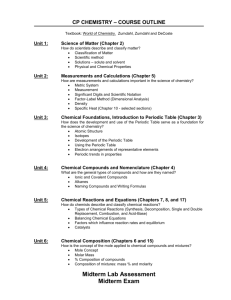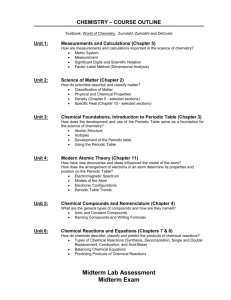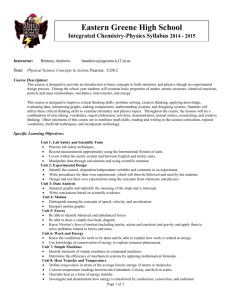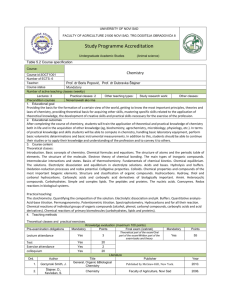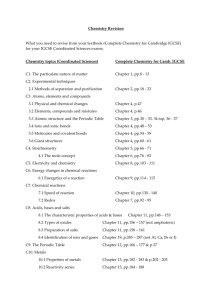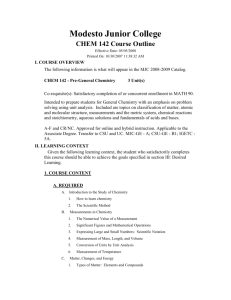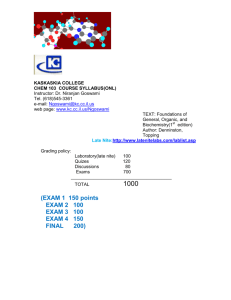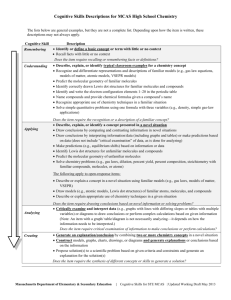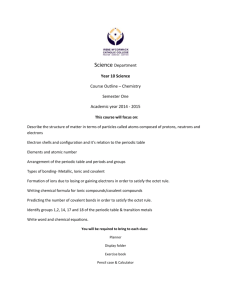PHYSICS
advertisement
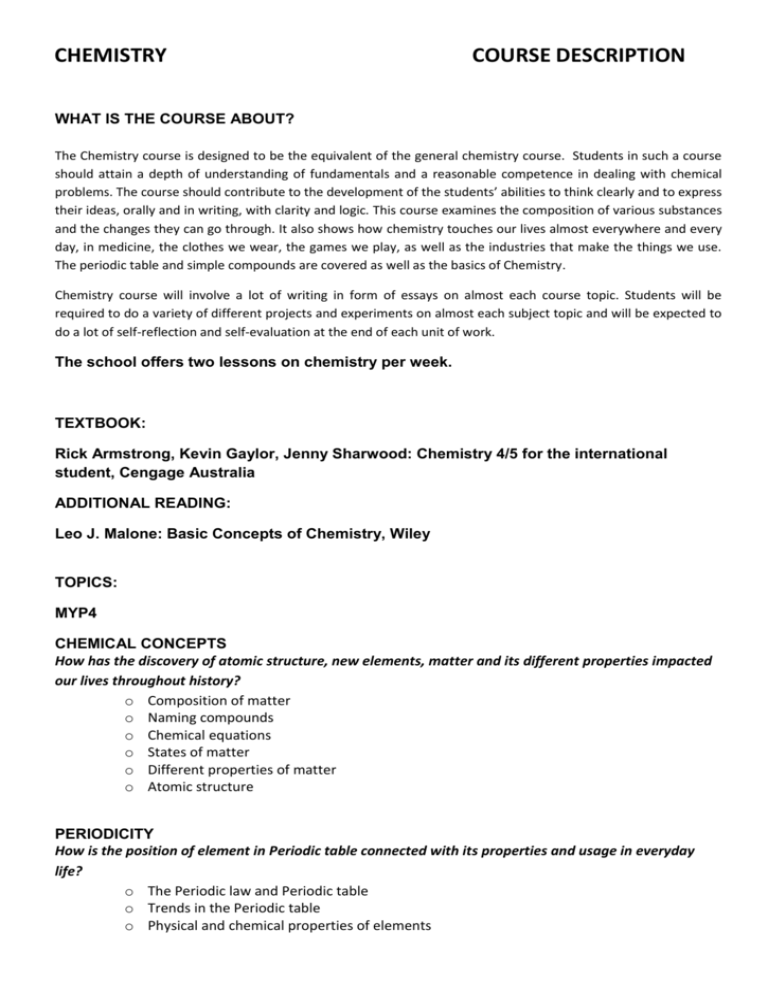
CHEMISTRY COURSE DESCRIPTION WHAT IS THE COURSE ABOUT? The Chemistry course is designed to be the equivalent of the general chemistry course. Students in such a course should attain a depth of understanding of fundamentals and a reasonable competence in dealing with chemical problems. The course should contribute to the development of the students’ abilities to think clearly and to express their ideas, orally and in writing, with clarity and logic. This course examines the composition of various substances and the changes they can go through. It also shows how chemistry touches our lives almost everywhere and every day, in medicine, the clothes we wear, the games we play, as well as the industries that make the things we use. The periodic table and simple compounds are covered as well as the basics of Chemistry. Chemistry course will involve a lot of writing in form of essays on almost each course topic. Students will be required to do a variety of different projects and experiments on almost each subject topic and will be expected to do a lot of self-reflection and self-evaluation at the end of each unit of work. The school offers two lessons on chemistry per week. TEXTBOOK: Rick Armstrong, Kevin Gaylor, Jenny Sharwood: Chemistry 4/5 for the international student, Cengage Australia ADDITIONAL READING: Leo J. Malone: Basic Concepts of Chemistry, Wiley TOPICS: MYP4 CHEMICAL CONCEPTS How has the discovery of atomic structure, new elements, matter and its different properties impacted our lives throughout history? o Composition of matter o Naming compounds o Chemical equations o States of matter o Different properties of matter o Atomic structure PERIODICITY How is the position of element in Periodic table connected with its properties and usage in everyday life? o The Periodic law and Periodic table o Trends in the Periodic table o Physical and chemical properties of elements STOICHIOMETRY How do balanced equations and ratios apply to both chemistry and everyday situations? o Chemical reaction o Relationships between compounds in balanced reactions o Mole ratio THERMOCHEMISTRY Why do we need to eat? o Energy changes in chemical reactions o Renewable and unrenewable sources of energy o Enthalpy and entropy of chemical reactions BONDING What are the differences between compounds differently bonded and how will those differences impact our life? o Intramolecular forces: ionic, metallic and covalent bonding o Intermolecular forces: van der Waals forces, dipole-dipole attraction and hydrogen bonding o Different properties of differently bonded compounds How can rate and equilibrium of chemical reaction be disturbed and what will be its consequence and contribution to our life? o Rate of chemical reaction o Factors that affect the rate o Chemical equilibrium o Le Chatelier’s principle ACIDS AND BASES How acid decomposition is formed and what is its effect on environment? o Theories of acids and bases: Arrhenius, Brønsted and Lewis o Structure of acids and bases o Strength of acids and bases o The ion product of water o pH and pOH o Acidobasic indicators and acidobasic titration o Properties, structure and naming salts ELECTROCHEMISTRY What is the relationship between chemical energy and electricity? o Redox reactions and oxidation numbers o Galvanic cells; Batteries o Standard electrode potentials o Electrolytic cells ORGANIC CHEMISTRY Is human demand for energy, which is usually gained by combustion of fossil fuel, justified reason for polluting the Earth? o Elementary carbon o Inorganic compounds of carbon o Structural types of organic compounds o Hydrocarbons - the simplest organic compounds o Saturated and unsaturated hydrocarbons and their typical reactions o Structure and properties of alcohols o The most important alcohols ASSESSMENT: -written tests (C, D, E) -scientific investigations / lab reports (A, B, D, E, F) -essays (A, B) -some of the homework (F) -oral exams through particular individual questions during the lessons (A, B, C, E) -observations (F) Students are assessed according to the prescribed (MYP5) and interim (MYP4) descriptors for grading. The students are given task specific descriptors together with each investigation or essay. At the end of the school year points are given in each criteria taking into account achievements in all individual tasks (formative and summative assessment). Final grades are derived according to the interim grade boundaries (MYP 4) or grade boundaries provided by the IB (MYP 5): MYP 4 MYP 5 BOUNDARIES BOUNDARIES 1 0–5 0–5 2 6 – 11 6 – 11 3 12 – 18 12 – 18 4 19 - 24 19 – 24 5 25 - 28 25 – 28 6 29 - 32 29 – 32 7 33 – 36 33 – 36 Grade
